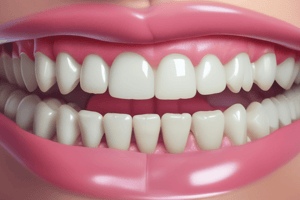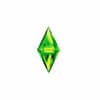Podcast
Questions and Answers
What is the primary characteristic of a Class II malocclusion?
What is the primary characteristic of a Class II malocclusion?
- Upper teeth and jaw protrude over the lower teeth and jaw (correct)
- Upper teeth and jaw are smaller than the lower teeth and jaw
- Upper and lower teeth are aligned perfectly
- Lower teeth and jaw are larger than the upper teeth and jaw
What is the purpose of ligatures in braces?
What is the purpose of ligatures in braces?
- To attach the archwires to the brackets
- To connect upper and lower teeth
- To apply pressure to move teeth
- To hold archwires in place (correct)
What type of orthodontic appliance is used to modify growth and development?
What type of orthodontic appliance is used to modify growth and development?
- Removable appliance
- Fixed appliance
- Functional appliance (correct)
- Retention appliance
What type of root movement involves the rotation of the root around its long axis?
What type of root movement involves the rotation of the root around its long axis?
What is a factor that affects the ease of root movement in orthodontic treatment?
What is a factor that affects the ease of root movement in orthodontic treatment?
What is the primary purpose of a retainer in orthodontic treatment?
What is the primary purpose of a retainer in orthodontic treatment?
Study Notes
Malocclusion
- Definition: A misalignment of the upper and lower teeth, affecting the way they fit together
- Types:
- Class I: Neutral occlusion, but with crowding or spacing issues
- Class II: Upper teeth and jaw protrude over the lower teeth and jaw
- Class III: Lower teeth and jaw protrude over the upper teeth and jaw
- Crossbite: Upper teeth fit behind the lower teeth, instead of over them
- Causes:
- Genetics
- Thumb-sucking or pacifier use
- Premature loss of baby teeth
- Trauma or injury
- Effects:
- Difficulty chewing or speaking
- Increased risk of tooth wear and tooth loss
- Impaired oral hygiene
- Decreased self-confidence
Braces
- Definition: Orthodontic appliances used to straighten and align teeth
- Types:
- Traditional metal braces: Stainless steel or titanium brackets and wires
- Ceramic braces: Clear or tooth-colored brackets and wires
- Lingual braces: Brackets and wires attached to the back of teeth
- Invisalign: Clear, removable aligners
- Components:
- Brackets: Attached to individual teeth
- Archwires: Connect brackets and apply pressure to move teeth
- Ligatures: Small rubber bands or wires that hold archwires in place
- Elastic bands: Used to connect upper and lower teeth
Orthodontic Appliances
- Definition: Devices used to move teeth, modify growth, or maintain space
- Types:
- Fixed appliances: Braces, bands, and wires
- Removable appliances: Retainers, aligners, and space maintainers
- Functional appliances: Modify growth and development, such as palatal expanders
- Examples:
- Headgear: Used to correct Class II or Class III malocclusion
- Retainers: Worn after treatment to maintain tooth alignment
- Space maintainers: Used to preserve space for permanent teeth
Root Movement
- Definition: The process of moving teeth roots through the bone
- Types:
- Tipping: Rotation of the root around a fixed point
- Bodily movement: Linear movement of the entire tooth
- Root torque: Rotation of the root around its long axis
- Factors affecting root movement:
- Age: Easier in younger patients, more challenging in adults
- Bone density: Softer bone allows for easier movement
- Treatment duration: Faster movement may lead to more relapse
- Force application: Light, continuous forces are more effective than heavy, intermittent forces
Studying That Suits You
Use AI to generate personalized quizzes and flashcards to suit your learning preferences.
Description
Test your knowledge of orthodontics with this quiz covering malocclusion types, braces, orthodontic appliances, and root movement. Learn about the causes and effects of malocclusion, types of braces and appliances, and factors affecting root movement.





